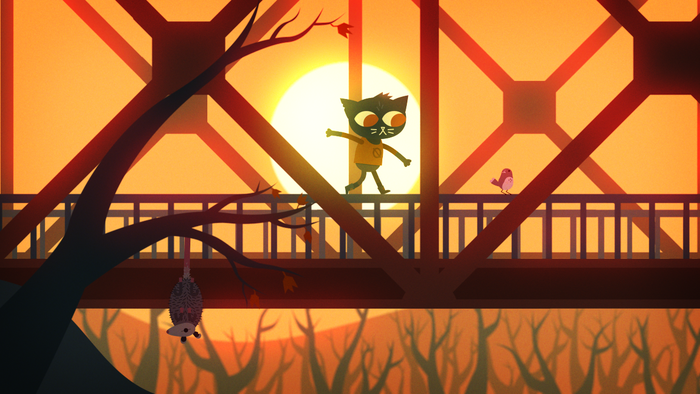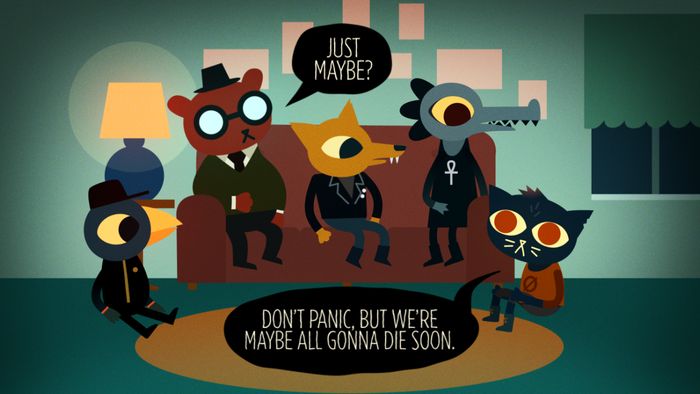When the credits rolled at the end of my first Night In The Woods playthrough, the feeling of clarity was almost surreal.
As a 20-something with my own history of struggles with mental health and finding a way through life, the game had struck a cord with me in a way no other ever had. Filled with flawed characters who were frightened and frustrated in the face of an unknown future, and touting a narrative which championed the power in admitting things can’t remain the same forever, it had left me with an experience I couldn’t compare to anything else in gaming. *Warning: Spoilers Ahead*
Trash Mammals And Proud
In most any entertainment medium, it’s more common than not that their offerings are in place to provide people with an escape; to provide them with something out of the ordinary to help them step out of their shoes and into those of someone powerful, destined for great things and sure of their purpose. Video games are no exception, with most every genre boasting characters ranging from super-powered badasses to blessed warriors chosen by fate to save the world.

It’s for this reason that Night in the Woods’ cast stands out the way it does. Set in a sleepy mountain town, the story follows Mae Borrowski, a 20 year old college dropout returning home to find a sense of order and direction in her life. She sleeps in ’til noon and spends the rest of the day looking for ways to distract herself, bugging her friends Greg, Bea and Angus at their minimum wage jobs. She’s overly hasty, quick to make a conversation awkward and constantly on the verge of vandalizing a car or local restroom. She’s a complete mess of a person, and the furthest thing from an ideal protagonist as you can get.
At the same time, she’s one of the best protagonists gaming has had in years.
Where other protagonists offer players the chance to escape into the role of someone else, Mae offers them the chance to reflect on themselves and their flaws. Mae’s attempts to fix a situation backfiring into an argument were frustrating to watch, but only because I’d been there on more than one occasion in my own life. Playing out a segment where Mae argues with a church minister about whether god cares or exists echoed struggles I had to find reason and meaning behind my own rough patches growing up, and I didn’t find answers that were any clearer than what Mae settled on.
It made Mae feel real in a way some super powered space marine never had, or could. She was someone who didn’t succeed in everything she did, and could only hope to keep trying and do her best.
A Colorful Cast
The game’s other characters offer similar moments of unexpected empathy. As the player gets to know Mae’s friends and the town’s other inhabitants, more parallels can be drawn between them and people the player might know in real life: The hyperactive Greg reveals his struggles with guilt and feeling worthy of love, as well as a regular struggle with his mood swinging high and low; Bea, constantly testy and exhausted from work, reveals her frustrations at feeling trapped in a life she doesn’t want but has no way of escaping from; Mae’s parents struggle to understand their daughter, but still do their best to be supportive in spite of everything.

The list goes on and on, but the result remains the same. Each character feels real and relatable, with their own flaws that continue to hinder them throughout the game. Through Infinite Fall’s writing, they come to life and become sympathetic in a way supremely powerful characters never could, and are all the better for it.
Not A Race, But A Marathon
Most notable of all, however, is how the game handles its characters’ progression and growth. Where most games and stories try to tie up every loose end by the conclusion, Night in the Woods is decidedly honest about the fact that that’s unrealistic. While Mae has made progress in addressing her problems and struggles, she has still only taken a small step forward by the end of the story. Likewise, Bea, Greg and everyone else aren’t magically cured of their problems by their final interaction with Mae. They still have to find ways to cope and manage with how they feel and act on a daily basis, and probably will for the remainder of their lives after the game concludes.

While some might find this depressing, it struck me as reassuring. Where other games gave me a temporary escape from the problems in my own life, Night in the Woods offered the outlook that it was ok that they were there; that it was ok if they couldn’t be solved with one simple action, that it was ok to be afraid to face them and that struggling to deal with them day in and day out was perfectly normal.
Where other games let players turn away from their problems, Night in the woods helps them look those issues in the eye, understand them, and find a way forward. It’s a one of a kind experience, and one I’d whole-heartedly recommend to anyone who wants to do more than forget about their struggles.
Night in the Woods is currently nominated in three categories at the Independent Games Festival 2018, including Excellence in Visual Art, Excellence in Narrative and the Seumas McNally Grand Prize. It is currently available on PlayStation 4 and PC for $19.99, with a Switch port set for release on February 1. For more on the game, check out this Q&A with co-creator Scott Benson as well as some great places to play the recently announced Switch version.



